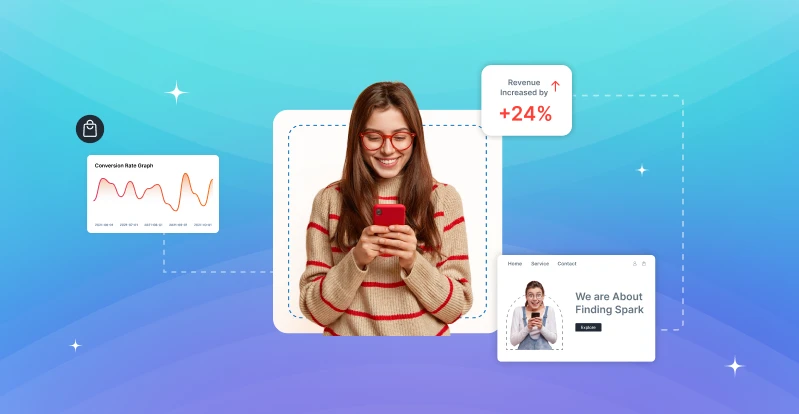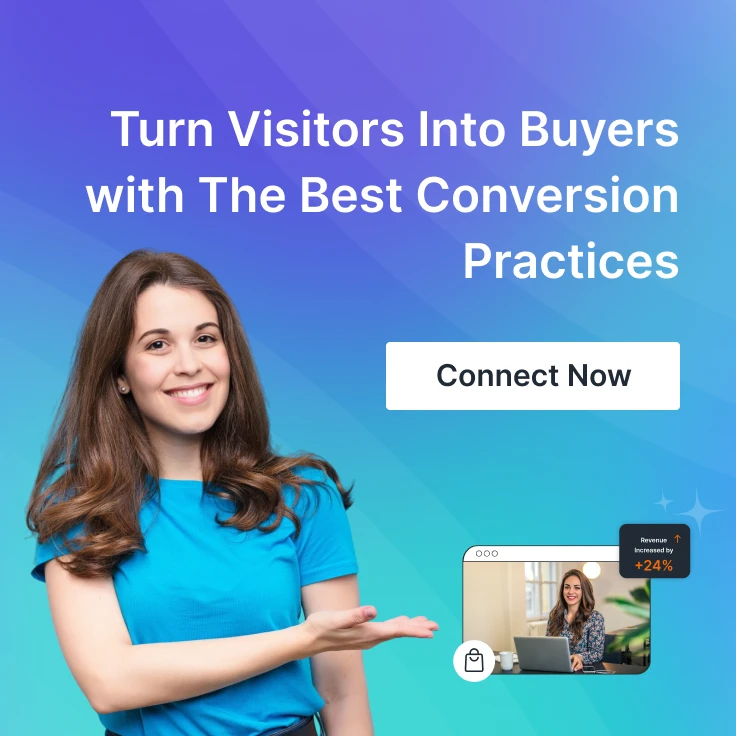Best Practices for Optimizing Your Online Store for Conversions

In today’s digital-first retail environment, simply driving traffic to your online store isn’t enough. If that traffic isn’t converting, you’re losing money and opportunities.
The focus must shift toward maximizing conversion rates, for turning casual browsers into loyal buyers. Whether you’re a seasoned eCommerce business owner or just starting out, mastering the best practices for optimizing your online store for conversions is essential for long-term success.
On average, eCommerce stores have a global conversion rate of only 2.5%, meaning that 97 out of every 100 visitors leave without making a purchase.
This blog will focus on proven strategies that improve user experience, build trust, and ultimately boost your conversion rate.
What is Conversion Rate Optimization (CRO)?
Conversion Rate Optimization (CRO) is the systematic process of increasing the percentage of website visitors who take a desired action, whether that’s making a purchase, filling out a form, signing up for a newsletter, or any other goal relevant to your business.
Rather than simply driving more traffic, CRO focuses on making your existing traffic more effective. This includes analyzing user behavior, testing changes, and implementing improvements to enhance the customer journey.
By understanding what motivates, distracts, or stops your users from converting, you can refine your website and marketing funnel to maximize outcomes. CRO encompasses A/B testing, usability improvements, persuasive copywriting, mobile responsiveness, page speed optimization, and much more.
Ultimately, it allows eCommerce businesses to increase revenue, lower customer acquisition costs, and deliver a better user experience, all without necessarily increasing traffic volume.
Why You Should Invest in Conversion Rate Optimization (CRO)
Higher ROI From Existing Traffic:
CRO helps you maximize the value of your existing visitors. By converting more users without increasing your traffic spend, you reduce acquisition costs and boost overall ROI, making your marketing efforts more efficient and profitable.
Improved User Experience:
A key part of CRO is optimizing for user behavior. Enhancing usability, simplifying navigation, and speeding up checkout makes shopping easier and more enjoyable, encouraging visitors to stay longer and convert more often.
Lower Customer Acquisition Costs:
Instead of spending more on ads, CRO allows you to make better use of your current traffic. This results in a lower cost per acquisition (CPA), enabling you to grow more sustainably and invest resources elsewhere.
Data-Driven Decision Making:
CRO relies on analytics and user feedback to inform decisions. Rather than guessing what might work, you can test, analyze, and optimize based on real behavior—leading to better, measurable outcomes over time.
Competitive Advantage:
Many online stores still underutilize CRO. By investing in conversion optimization, you can gain an edge over competitors who are focused solely on traffic, enabling your store to convert more visitors and win more customers.
15 Best Practices for Optimizing Your Online Store for Conversions
Prioritize a Clean and Intuitive Website Design
First impressions matter, especially in eCommerce where customers judge your brand within seconds. A clean, intuitive design instills trust and encourages deeper browsing. Use a balanced color scheme, consistent typography, and logical layout to make the site visually appealing.
Clear navigation menus and strategically placed categories help visitors find what they need quickly, minimizing friction. White space should be used effectively to guide the eye toward calls-to-action (CTAs) and important product details. Responsive design is critical—ensure your store adapts seamlessly across desktops, tablets, and smartphones.
A mobile-optimized layout is no longer optional as mobile users now drive the majority of online sales. Incorporate user experience (UX) best practices like sticky headers, search functionality, and clear category breadcrumbs. Additionally, run usability tests and analyze heatmaps to identify areas of confusion or drop-off.
An intuitive design not only enhances user experience but also contributes significantly to higher conversion rates by making the shopping journey easy, fast, and enjoyable from start to finish.
Streamline the Checkout Process
A complicated or lengthy checkout process is a major barrier to conversions. To minimize cart abandonment, streamline your checkout by removing unnecessary steps and reducing the number of fields customers must fill out.
Allow guest checkout to appeal to first-time buyers who may not want to create an account. Include a progress indicator so users can see how many steps remain, helping them commit to completing the process. Use auto-fill and address validation tools to reduce typing effort, especially on mobile. Offering multiple secure payment options, like credit cards, digital wallets, and services like Klarna, caters to varied preferences. Display order summaries with shipping costs upfront to avoid surprises.
Trust badges, SSL certificates, and clear return policies reinforce customer confidence. Consider integrating one-click purchasing for returning users to expedite repeat purchases. Each touchpoint should be optimized for ease and security.
By reducing friction, increasing transparency, and building trust throughout the checkout process, you can significantly increase your store’s conversion rates and turn more browsers into buyers. Nearly 70% of online shopping carts are abandoned, with complicated checkouts being one of the top reasons
Leverage High-Quality Product Images and Videos
Visual content is one of the most influential factors in online purchasing decisions. Since customers can’t touch or try products in person, your images and videos must do the heavy lifting. Invest in professional photography to showcase products from multiple angles and in high resolution.
Use zoom features and 360-degree views to help shoppers examine fine details. Include lifestyle imagery to help users visualize the product in use, enhancing emotional appeal.
Video content—such as product demos, how-tos, or customer testimonials—adds a dynamic layer that builds confidence and provides context.
Make sure visual assets are optimized for fast loading without compromising quality, especially on mobile devices. Product videos can increase purchases by up to 144%.
Consider incorporating user-generated content like customer photos or videos for added authenticity and trust. Use consistent lighting, backgrounds, and formatting across your product catalog for a polished brand presentation.
High-quality visuals not only create a more engaging shopping experience but also reduce returns and increase conversions by giving customers everything they need to make informed decisions.

Write Persuasive and Informative Product Descriptions
Compelling product descriptions serve both to inform and persuade potential buyers. A strong description goes beyond listing features, it highlights the benefits and unique value the product brings to the customer. Use a conversational tone that matches your brand voice while clearly addressing pain points or desires.
Instead of simply stating “made from cotton,” say “experience all-day comfort with our breathable cotton fabric.” Incorporate bullet points for easy skimming and include essential details like dimensions, care instructions, and compatibility. Utilize storytelling to create a connection and make the product memorable.
Integrate SEO keywords naturally to boost search visibility without compromising readability. Address common customer questions or objections upfront to minimize hesitation and reduce bounce rates. Including information like warranty, usage tips, and who the product is best for can further aid decision-making.
Well-crafted product descriptions improve engagement, drive conversions, and help customers feel confident in their purchase decisions, ultimately lowering return rates and increasing satisfaction.
Build Trust with Social Proof and Reviews
Social proof reassures potential buyers by showing them that others have purchased and enjoyed your products. Displaying product reviews, star ratings, and testimonials prominently on product pages builds credibility and reduces purchase anxiety.
Authenticity matters, for encourage a mix of reviews, including constructive feedback, to show transparency and build trust.
Highlight top-rated products or trending items to leverage herd mentality. Include photos or videos from real customers using the product to add relatability and visual validation.
Featuring influencer testimonials or endorsements from trusted industry sources can further strengthen your credibility. Incorporate trust badges such as SSL security, verified payments, and money-back guarantees on key pages.
If your brand has been featured in the media or has a large social following, showcase that with logos or numbers.
By making social proof visible throughout the buyer journey, you provide the reassurance needed to convert skeptical visitors into loyal customers, all while enhancing brand reputation and fostering community engagement.
Use Clear and Compelling Calls-to-Action (CTAs)
Your Calls-to-Action (CTAs) are the gateway to conversions, so they must be clear, visible, and persuasive. Use action-oriented language that tells users exactly what to expect, such as “Buy Now,” “Get Started,” or “Add to Cart.”
Avoid vague terms like “Click Here.” CTAs should stand out visually through contrasting colors and strategic placement—ideally above the fold and near key decision points.
Each CTA should align with the stage of the customer journey, whether it’s browsing, comparison, or final purchase. Test different phrasing, colors, and button sizes to determine what drives the highest engagement.
Use urgency or scarcity when appropriate (e.g., “Limited Stock” or “Offer Ends Soon”) to nudge users toward faster decisions. On mobile, ensure buttons are thumb-friendly and not too small to tap easily.
Finally, never overcrowd a page with too many CTAs, which can overwhelm visitors. Clear and compelling CTAs serve as directional cues for your users, guiding them naturally through your site and toward conversion, without confusion or hesitation.
Optimize Site Speed and Performance
Page load speed is a critical factor for both user experience and SEO. A slow-loading website frustrates users and increases bounce rates, leading to lost sales. Aim for a load time of under three seconds across all devices.
Use tools like Google PageSpeed Insights to diagnose speed bottlenecks. Compress images, enable lazy loading, and minimize the use of heavy scripts. Leverage browser caching and content delivery networks (CDNs) to improve load times globally.
Reduce redirects and eliminate unnecessary plugins that can slow down performance. Sites that load in 1 second have a conversion rate 3x higher than sites that load in 5 seconds.
On mobile, optimize for responsive behavior and lightweight design elements that still look polished. Fast websites keep visitors engaged and moving through the funnel smoothly. They also build trust—users are more likely to complete purchases when a site responds quickly.
Site speed improvements can be the low-hanging fruit that delivers noticeable gains in conversion rates, especially for high-traffic stores.
In competitive eCommerce, performance can be the differentiator between a visitor bouncing or becoming a loyal customer.
Offer Free Shipping and Transparent Pricing
Unexpected costs at checkout are one of the top reasons for cart abandonment. Offering free shipping, or at least clearly communicating shipping costs upfront—can significantly boost conversions.
Highlight free shipping offers on banners, product pages, and during checkout. If you can’t provide free shipping universally, consider setting a minimum order threshold to incentivize larger purchases.
Ensure all pricing is transparent, which include taxes, fees, and delivery estimates early in the process. Surprise costs erode trust and cause shoppers to abandon their carts.
Additionally, offer multiple shipping speed options to cater to different needs, from economy to express.
Use badges like “Free Shipping Over $50” or “No Hidden Fees” to visually reinforce pricing clarity. Display estimated delivery dates to help set expectations. Being upfront about costs reduces friction and builds trust, especially among new customers.
In a competitive market, transparency and perceived value can make the difference between winning or losing a sale.
Enable Live Chat and Real-Time Assistance
Modern consumers expect instant support, and live chat tools fulfill that need by offering real-time assistance. Adding a live chat widget to your store allows customers to ask questions without leaving the site, removing barriers to purchase.
Live chat can address doubts about product fit, delivery times, return policies, or technical issues. Consider using AI-powered chatbots for quick answers outside of business hours and live agents for more complex queries.
Use proactive chat triggers like “Need help?” on exit intent or prolonged page views to engage hesitant shoppers.
Ensure your support team is trained to respond promptly and provide useful, friendly assistance. Beyond boosting conversions, live chat also reduces support tickets by solving problems before they escalate. It also builds confidence in your brand’s responsiveness and customer service quality.
For high-ticket items or B2B sales, having an expert available via chat can significantly shorten the sales cycle and increase average order value.
Personalize the Shopping Experience
Personalization enhances user engagement by making the shopping experience more relevant to individual visitors. Use behavioral data such as browsing history, previous purchases, and geolocation to display personalized product recommendations, promotions, or content.
A returning user might see “Welcome back” messages and be shown items they previously viewed. New visitors might get a discount pop-up or guided navigation help.
Dynamic retargeting ads can remind shoppers of products they left in their cart or viewed but didn’t purchase.
Email follow-ups with personalized offers based on behavior can also boost return visits and conversions. Make sure the personalization is subtle, timely, and helpful—overly aggressive tactics can feel invasive. Personalization should feel like a concierge service, not surveillance.
When done right, it creates a sense of connection and relevance, helping customers feel understood and catered to. This emotional engagement not only increases conversion rates but also builds loyalty over time.
Create Urgency and Scarcity Tactics
Urgency and scarcity are powerful psychological triggers that compel users to act quickly. Tactics like countdown timers for flash sales, “only 3 left in stock” notices, or “order in the next 2 hours for same-day shipping” can prompt faster decisions.
These methods tap into the fear of missing out (FOMO), nudging hesitant buyers off the fence. Scarcity should always be genuine; falsely inflating urgency can damage credibility. Combine urgency with visual cues like red text or icons to draw attention.
Use urgency sparingly and strategically—overuse can desensitize users or even annoy them. Integrate real-time stock levels or limited-time offers on product pages and in checkout flows to reinforce action.
You can also use urgency in email campaigns to re-engage cart abandoners. When executed authentically and ethically, urgency and scarcity increase conversion rates by reducing hesitation and accelerating the decision-making process.
Incorporate Exit-Intent Popups with Incentives
Exit-intent popups appear when a user is about to leave your website, giving you one last chance to convert them. These popups can offer a discount, free shipping, or a lead magnet like a size guide or style tips in exchange for an email signup. Timing and relevance are key—make the offer compelling and ensure the design is non-intrusive.
Use clear copy, contrasting colors, and a single CTA. Avoid overwhelming visitors with too many popups throughout their visit.
A well-designed exit-intent pop-up can capture leads for future marketing or convert a hesitant buyer on the spot.
For returning users, personalize the offer based on their browsing behavior. Exit popups also allow A/B testing of different value propositions to see what resonates most. When thoughtfully implemented, this technique gives you a second chance to secure a conversion that otherwise would have been lost.
Simplify Site Navigation and Search Functionality
Navigation should be intuitive, helping users find what they need with minimal effort. Clear categories, filters, and a logical menu structure improve usability and reduce frustration.
Sticky headers, breadcrumb trails, and featured categories on the homepage further guide exploration.
A prominent and functional search bar with auto-suggestions and spellcheck makes it easy for users to locate specific products. Allow filtering by size, color, price, and availability to help narrow down results.

Use smart search that returns relevant results even with misspellings or synonyms. Site architecture should support both casual browsing and goal-directed shopping. Test navigation flows using heatmaps and click tracking to identify common paths and drop-off points.
A simplified structure leads to a smoother journey and improves your chances of converting first-time visitors into customers. Clear navigation reduces bounce rates and increases user satisfaction, ultimately contributing to higher conversions.
Implement a Seamless Mobile Shopping Experience
With mobile commerce continually rising, your store must deliver a seamless experience on smartphones and tablets. Mobile optimization goes beyond responsive design—it’s about prioritizing speed, touch-friendly elements, and streamlined functionality.
Simplify menus and navigation for smaller screens, and ensure all buttons are easily tappable. Avoid popups that cover too much screen space or are hard to close. Use mobile-specific features like click-to-call, Apple Pay, or location-based personalization.
Test your entire user journey on various mobile devices to catch design inconsistencies and technical bugs. Optimize product pages, cart functions, and checkout processes specifically for mobile behavior, where users may be more distracted or on the go.
Google also uses mobile performance as a ranking factor, so a well-optimized mobile experience aids SEO. Delivering a polished, intuitive mobile shopping experience ensures you’re not missing out on this fast-growing customer segment and helps maximize conversion opportunities from mobile traffic.
Monitor Analytics and Continuously Test Improvements
Conversion optimization is an ongoing process, not a one-time fix. Use analytics tools like Google Analytics, Hotjar, or Shopify reports to monitor key metrics for conversion rate, bounce rate, cart abandonment, and average order value. Identify where users drop off and what pages have the highest exits.
Regularly conduct A/B tests on headlines, layouts, CTAs, and product page formats. Even small tweaks can yield measurable improvements.
Heatmaps, scroll maps, and session replays offer insights into real user behavior, helping you spot UX issues or opportunities. Combine quantitative data with qualitative feedback through surveys or user testing.
Prioritize testing ideas based on potential impact and ease of implementation. Document results and use them to inform future decisions.
By staying data-driven and iterative, you continually refine your store and stay ahead of customer expectations. This proactive mindset helps sustain growth, improve performance, and ensure long-term conversion success.
Conclusion
Optimizing your online store for conversions is not a one-time task, it’s a continuous, data-driven process rooted in understanding your customers and refining every aspect of their journey.
From enhancing site speed and simplifying navigation to leveraging personalization and building trust through social proof, each strategy contributes to removing friction and guiding users toward purchase decisions.
With consumer expectations evolving rapidly, brands that prioritize conversion rate optimization (CRO) gain a competitive edge not only in boosting revenue but also in customer satisfaction and long-term loyalty.
By implementing the best practices outlined above and continually testing what works best for your audience, you create a seamless and persuasive online experience.
The result is a store that not only attracts traffic but consistently turns that traffic into measurable results. Remember, small improvements can lead to significant gains over time—so start optimizing today, and turn every visitor into a valuable customer.
For expert guidance, connect with a CRO specialist and make your business grow like never before.
FAQs
 What does conversion rate mean in eCommerce?
What does conversion rate mean in eCommerce?
A conversion rate indicates the percentage of visitors who take a desired action on your online store, such as purchasing a product, signing up for a newsletter, or adding items to their cart.
 Why is conversion rate optimization (CRO) important?
Why is conversion rate optimization (CRO) important?
CRO helps you get more sales from the traffic you already have. Instead of spending extra money to bring in new visitors, CRO improves the shopping experience and encourages more people to buy.
 What are the common reasons visitors don’t convert?
What are the common reasons visitors don’t convert?
Some common reasons include slow website speed, confusing navigation, poor product information, high shipping costs, or a complicated checkout process.
 How can I improve my checkout process?
How can I improve my checkout process?
Keep it short and simple, allow guest checkout, reduce the number of form fields, show clear shipping costs upfront, and provide multiple payment options.




